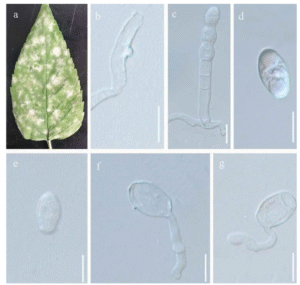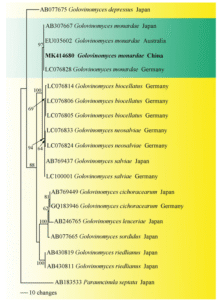Golovinomyces monardae (G.S. Nagy) M. Scholler, U. Braun & Anke Schmidt, in Scholler et al., Mycol. Progr. 15(no. 56): 4 (2016) Fig. 39
Index Fungorum number: IF 815612 ; MycoBank number: MB 556431
White powdery layers effuse, on both sides of leaves, but more evident on the upper leaf surface. Hyphal appressoria nipple-shaped, solitary. Conidiophores (50.3–) 62.5–110 × 9.2–13.5 μm, arising from the upper surface of hyphal mother cells. Foot cells 31.6–81.0 × 8.8–13.6 μm, mostly curved at the base, basal septum of the foot-cell partly raised above the junction with the hyphal mother cell up to 14.6 μm, foot-cell followed by 1–3 shorter cells, forming catenescent conidia; conidia mostly ellipsoid, partly doliiform, 24.5–40.8 × 14.4–19.4 μm, length/width ratio 1.4–2.4; germ tubes mostly short to moderately long, terminating simply or in a nipple-shaped appressorium, producing at the top or perihilar of the conidia.
Material examined: CHINA, Jilin Province, Changchun, Jilin Agricultural University, on Monarda didyma, 22 August 2018, P.L. Qiu (HMJAU-PM91795).
GenBank numbers: ITS: MK414680; LSU: MK951687; IGS: MK955882.
Notes: Golovinomyces monardae sensu stricto was split from the G. biocellatus complex by Scholler et al. (2016), based on the distinct morphology and phylogenetic analysis. The species is mostly found on Lamiaceae and occasionally on Verbenaceae plants. The phylogenetic analysis based on ITS sequences demonstrated that the powdery mildew found on M. didyma is G. monardae which is distinct from G. neosalviae, G. salviae and G. biocellatus (Fig. 40). The current fungus has the characters of G. monardae in Scholler et al. (2016)

Fig. 39 Symptom of powdery moldew on Monarda didyma and microscopic structures of Golovinomyces monardae (HMJAU PM91795, new geographical record). a White, effused powdery layers on diseased plant leaf. b Hyphal appressorium with distinct nipple-shaped. c Conidiophore. d, e conidia. f, g Geminated conidium. Scale bars: a–g = 20 µm

Fig. 40 Maximum parsimony tree based on ITS sequences of Golovinomyces. Bootstrap support values ≥ 50% are given near nodes respectively. The tree is rooted with Parauncinula septata (MUMH585). The new strain is in bold
